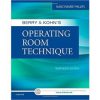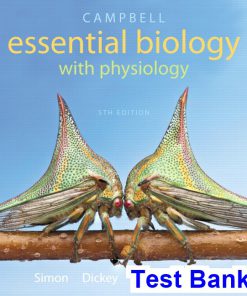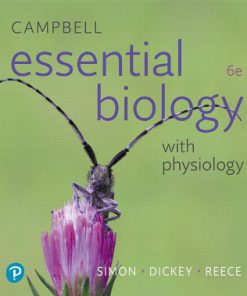Campbell Essential Biology 6th Edition Simon Test Bank
$35.00 Original price was: $35.00.$26.50Current price is: $26.50.
Campbell Essential Biology 6th Edition Simon Test Bank
Campbell Essential Biology 6th Edition Simon Test Bank

Product details:
- ISBN-10 : 9780133917789
- ISBN-13 : 978-0133917789
- Author: Simon, Neil A. Campbell
Campbell Essential Biology makes biology interesting and understandable for non-majors biology students. This best-selling textbook, known for its scientific accuracy, clear explanations, and intuitive illustrations, has been revised to further emphasize the relevance of biology to everyday life, using memorable analogies, real-world examples, conversational language, engaging new Why Biology Matters photo essays, and more. New MasteringBiology activities engage students outside of the classroom and help students develop scientific literacy skills.
Table contents:
UNIT 1: CELLS
2. Essential Chemistry for Biology
CHAPTER THREAD
Helpful Radiation
BIOLOGY AND SOCIETY: Nuclear Medicine
Some Basic Chemistry
Matter: Elements and Compounds
Atoms
THE PROCESS OF SCIENCE: How Effective Is Radiation in Treating Prostate Cancer?
Chemical Bonding and Molecules
Chemical Reactions
Water and Life
Water
Acids, Bases, and pH
EVOLUTION CONNECTION: Radioactivity as an Evolutionary Clock
3. The Molecules of Life
CHAPTER THREAD
Lactose Intolerance
BIOLOGY AND SOCIETY: Got Lactose?
Organic Compounds
Carbon Chemistry
Giant Molecules from Smaller Building Blocks
Large Biological Molecules
Carbohydrates
Lipids
Proteins
Nucleic Acids
THE PROCESS OF SCIENCE: Does Lactose Intolerance Have a Genetic Basis?
EVOLUTION CONNECTION: The Evolution of Lactose Intolerance in Humans
4. A Tour of the Cell
CHAPTER THREAD
Humans Versus Bacteria
BIOLOGY AND SOCIETY: Antibiotics: Drugs That Target Bacterial Cells
The Microscopic World of Cells
The Two Major Categories of Cells
An Overview of Eukaryotic Cells
Membrane Structure
The Plasma Membrane
Cell Surfaces
THE PROCESS OF SCIENCE: How Was the First 21st-Century Antibiotic Discovered?
The Nucleus and Ribosomes: Genetic Control of the Cell
The Nucleus
Ribosomes
How DNA Directs Protein Production
The Endomembrane System: Manufacturing and Distributing Cellular Products
The Endoplasmic Reticulum
The Golgi Apparatus
Lysosomes
Vacuoles
Chloroplasts and Mitochondria: Providing Cellular Energy
Chloroplasts
Mitochondria
The Cytoskeleton: Cell Shape and Movement
Maintaining Cell Shape
Flagella and Cilia
EVOLUTION CONNECTION: The Evolution of Bacterial Resistance in Humans
5. The Working Cell
CHAPTER THREAD
Nanotechnology
BIOLOGY AND SOCIETY: Harnessing Cellular Structures
Some Basic Energy Concepts
Conservation of Energy
Heat
Chemical Energy
Food Calories
ATP and Cellular Work
The Structure of ATP
Phosphate Transfer
The ATP Cycle
Enzymes
Activation Energy
THE PROCESS OF SCIENCE: Can Enzymes Be Engineered?
Enzyme Activity
Enzyme Inhibitors
Membrane Function
Passive Transport: Diffusion across Membranes
Osmosis and Water Balance
Active Transport: The Pumping of Molecules across Membranes
Exocytosis and Endocytosis: Traffic of Large Molecules
EVOLUTION CONNECTION: The Origin of Membranes
6. Cellular Respiration: Obtaining Energy from Food
CHAPTER THREAD
Exercise Science
BIOLOGY AND SOCIETY: Getting the Most Out of Your Muscles
Energy Flow and Chemical Cycling in the Biosphere
Producers and Consumers
Chemical Cycling between Photosynthesis and Cellular Respiration
Cellular Respiration: Aerobic Harvest of Food Energy
An Overview of Cellular Respiration
The Three Stages of Cellular Respiration
The Results of Cellular Respiration
Fermentation: Anaerobic Harvest of Food Energy
Fermentation in Human Muscle Cells
THE PROCESS OF SCIENCE: What Causes Muscle Burn?
Fermentation in Microorganisms
EVOLUTION CONNECTION: The Importance of Oxygen
7. Photosynthesis: Using Light to Make Food
CHAPTER THREAD
Solar Energy
BIOLOGY AND SOCIETY: A Solar Revolution
The Basics of Photosynthesis
Chloroplasts: Sites of Photosynthesis
An Overview of Photosynthesis
The Light Reactions: Converting Solar Energy to Chemical Energy
The Nature of Sunlight
THE PROCESS OF SCIENCE: What Colors of Light Drive Photosynthesis?
Chloroplast Pigments
How Photosystems Harvest Light Energy
How the Light Reactions Generate ATP and NADPH
The Calvin Cycle: Making Sugar from Carbon Dioxide
EVOLUTION CONNECTION: Creating a Better Biofuel Factory
UNIT 2: GENETICS
8. Cellular Reproduction: Cells from Cells
CHAPTER THREAD
Life with and without Sex
BIOLOGY AND SOCIETY: Virgin Birth of a Shark
What Cell Reproduction Accomplishes
The Cell Cycle and Mitosis
Eukaryotic Chromosomes
The Cell Cycle
Mitosis and Cytokinesis
Cancer Cells: Dividing Out of Control
Meiosis, the Basis of Sexual Reproduction
Homologous Chromosomes
Gametes and the Life Cycle of a Sexual Organism
The Process of Meiosis
Review: Comparing Mitosis and Meiosis
The Origins of Genetic Variation
THE PROCESS OF SCIENCE: Do All Animals Have Sex?
When Meiosis Goes Wrong
EVOLUTION CONNECTION: The Advantages of Sex
9. Patterns of Inheritance
CHAPTER THREAD
Dog Breeding
BIOLOGY AND SOCIETY: Darwin’s Dogs
Genetics and Heredity
In an Abbey Garden
Mendel’s Law of Segregation
Mendel’s Law of Independent Assortment
Using a Testcross to Determine an Unknown Genotype
The Rules of Probability
Family Pedigrees
Human Traits Controlled by a Single Gene
THE PROCESS OF SCIENCE: What Is the Genetic Basis of Short Legs in Dogs?
Variations on Mendel’s Laws
Incomplete Dominance in Plants and People
ABO Blood Groups: An Example of Multiple Alleles and Codominance
Pleiotropy and Sickle-Cell Disease
Polygenic Inheritance
Epigenetics and the Role of Environment
The Chromosomal Basis of Inheritance
Linked Genes
Sex Determination in Humans
Sex-Linked Genes
EVOLUTION CONNECTION: Barking Up the Evolutionary Tree
10. The Structure and Function of DNA
CHAPTER THREAD
Deadly Viruses
BIOLOGY AND SOCIETY: The Global Threat of Zika Virus
DNA: Structure and Replication
DNA and RNA Structure
Watson and Crick’s Discovery of the Double Helix
DNA Replication
From DNA to RNA to Protein
How an Organism’s Genotype Determines Its Phenotype
From Nucleotides to Amino Acids: An Overview
The Genetic Code
Transcription: From DNA to RNA
The Processing of Eukaryotic RNA
Translation: The Players
Translation: The Process
Review: DNA S RNA S Protein
Mutations
Viruses and Other Noncellular Infectious Agents
Bacteriophages
Plant Viruses
Animal Viruses
THE PROCESS OF SCIENCE: Can DNA and RNA Vaccines Protect Against Viruses?
HIV, the AIDS Virus
Prions
EVOLUTION CONNECTION: Emerging Viruses
11. How Genes Are Controlled
CHAPTER THREAD
Cancer
BIOLOGY AND SOCIETY: Breast Cancer and Chemotherapy
How and Why Genes Are Regulated
Gene Regulation in Bacteria
Gene Regulation in Eukaryotic Cells
Cell Signaling
Homeotic Genes
Visualizing Gene Expression
Cloning Plants and Animals
The Genetic Potential of Cells
Reproductive Cloning of Animals
Therapeutic Cloning and Stem Cells
The Genetic Basis of Cancer
Genes That Cause Cancer
THE PROCESS OF SCIENCE: Can Avatars Improve Cancer Treatment?
Cancer Risk and Prevention
EVOLUTION CONNECTION: The Evolution of Cancer in the Body
12. DNA Technology
CHAPTER THREAD
DNA Profiling
BIOLOGY AND SOCIETY: Using DNA to Establish Guilt and Innocence
Genetic Engineering
Recombinant DNA Techniques
Gene Editing
Medical Applications
Genetically Modified Organisms in Agriculture
Human Gene Therapy
DNA Profiling and Forensic Science
DNA Profiling Techniques
Investigating Murder, Paternity, and Ancient DNA
Bioinformatics
DNA Sequencing
Genomics
Genome-Mapping Techniques
The Human Genome
THE PROCESS OF SCIENCE: Did Nic Have a Deadly Gene?
Applied Genomics
Systems Biology
Safety and Ethical Issues
The Controversy over Genetically Modified Foods
Ethical Questions Raised by Human DNA Technologies
EVOLUTION CONNECTION: The Y Chromosome as a Window on History
UNIT 3: EVOLUTION AND DIVERSITY
13. How Populations Evolve
CHAPTER THREAD
Evolution in Action
BIOLOGY AND SOCIETY: Mosquitoes and Evolution
The Diversity of Life
Naming and Classifying the Diversity of Life
Explaining the Diversity of Life
Charles Darwin and The Origin of Species
Darwin’s Journey
Darwin’s Theory
Evidence of Evolution
Evidence from Fossils
Evidence from Homologies
Evolutionary Trees
Natural Selection as the Mechanism for Evolution
Natural Selection in Action
Key Points about Natural Selection
The Evolution of Populations
Sources of Genetic Variation
Populations as the Units of Evolution
Analyzing Gene Pools
Population Genetics and Health Science
Microevolution as Change in a Gene Pool
Mechanisms of Evolution
Natural Selection
Genetic Drift
Gene Flow
Natural Selection: A Closer Look
THE PROCESS OF SCIENCE: Did Natural Selection Shape the Beaks of Darwin’s Finches?
EVOLUTION CONNECTION: The Rising Threat of Antibiotic Resistance
14. How Biological Diversity Evolves
CHAPTER THREAD
Evolution in the Human-Dominated World
BIOLOGY AND SOCIETY: Humanity’s Footprint
The Origin of Species
What Is a Species?
Reproductive Barriers between Species
Mechanisms of Speciation
THE PROCESS OF SCIENCE: Do Human Activities Facilitate Speciation?
Earth History and Macroevolution
The Fossil Record
Plate Tectonics and Biogeography
Mass Extinctions and Explosive Diversifications of Life
Mechanisms of Macroevolution
Large Effects from Small Genetic Changes
The Evolution of Biological Novelty
Classifying the Diversity of Life
Classification and Phylogeny
Classification: A Work in Progress
EVOLUTION CONNECTION: Evolution in the Anthropocene
15. The Evolution of Microbial Life
CHAPTER THREAD
Human Microbiota
BIOLOGY AND SOCIETY: Our Invisible Inhabitants
Major Episodes in the History of Life
The Origin of Life
A Four-Stage Hypothesis for the Origin of Life
From Chemical Evolution to Darwinian Evolution
Prokaryotes
They’re Everywhere!
The Structure and Function of Prokaryotes
The Ecological Impact of Prokaryotes
The Two Main Branches of Prokaryotic Evolution: Bacteria and Archaea
THE PROCESS OF SCIENCE: Are Intestinal Microbiota to Blame for Obesity?
Protists
Protozoans
Slime Molds
Unicellular and Colonial Algae
Seaweeds
EVOLUTION CONNECTION: The Sweet Life of Streptococcus mutans
16. The Evolution of Plants and Fungi
CHAPTER THREAD
Plant-Fungus Interactions
BIOLOGY AND SOCIETY: The Diamond of the Kitchen
Colonizing Land
Terrestrial Adaptations of Plants
Plant Diversity
Highlights of Plant Evolution
Bryophytes
Ferns
Gymnosperms
Angiosperms
Plant Diversity as a Nonrenewable Resource
Fungi
Characteristics of Fungi
THE PROCESS OF SCIENCE: What Killed the Pines?
The Ecological Impact of Fungi
Commercial Uses of Fungi
EVOLUTION CONNECTION: A Pioneering Partnership
17. The Evolution of Animals
CHAPTER THREAD
Human Evolution
BIOLOGY AND SOCIETY: Evolving Adaptability
The Origins of Animal Diversity
What Is an Animal?
Early Animals and the Cambrian Explosion
Animal Phylogeny
Major Invertebrate Phyla
Sponges
Cnidarians
Molluscs
Flatworms
Annelids
Roundworms
Arthropods
Echinoderms
Vertebrate Evolution and Diversity
Characteristics of Chordates
Fishes
Amphibians
Reptiles
Mammals
The Human Ancestry
The Evolution of Primates
The Emergence of Humankind
THE PROCESS OF SCIENCE: What Can Lice Tell Us About Ancient Humans?EVOLUTION CONNECTION: Are We Still Evolving?
UNIT 4: ECOLOGY
18. An Introduction to Ecology and the Biosphere
CHAPTER THREAD
Climate Change
BIOLOGY AND SOCIETY: Penguins, Polar Bears, and People in Peril
An Overview of Ecology
Ecology and Environmentalism
A Hierarchy of Interactions
Living in Earth’s Diverse Environments
Abiotic Factors of the Biosphere
The Evolutionary Adaptations of Organisms
Adjusting to Environmental Variability
Biomes
Freshwater Biomes
Marine Biomes
How Climate Affects Terrestrial Biome Distribution
Terrestrial Biomes
The Water Cycle
Human Impact on Biomes
Climate Change
The Greenhouse Effect and Global Warming
The Accumulation of Greenhouse Gases
Effects of Climate Change on Ecosystems
THE PROCESS OF SCIENCE: How Does Climate Change Affect Species Distribution?
Looking to Our Future
EVOLUTION CONNECTION: Climate Change as an Agent of Natural Selection
19. Population Ecology
CHAPTER THREAD
Biological Invasions
BIOLOGY AND SOCIETY: Invasion of the Lionfish
An Overview of Population Ecology
Population Density
Population Age Structure
Life Tables and Survivorship Curves
Life History Traits as Adaptations
Population Growth Models
The Exponential Population Growth Model: The Ideal of an Unlimited Environment
The Logistic Population Growth Model: The Reality of a Limited
Environment
Regulation of Population Growth
Applications of Population Ecology
Conservation of Endangered Species
Sustainable Resource Management
Invasive Species
Biological Control of Pests
THE PROCESS OF SCIENCE: Can Fences Stop Cane Toads?
Integrated Pest Management
Human Population Growth
The History of Human Population Growth
Age Structures
Our Ecological Footprint
EVOLUTION CONNECTION: Humans as an Invasive Species
20. Communities and Ecosystems
CHAPTER THREAD
Importance of Biodiversity
BIOLOGY AND SOCIETY: Why Biodiversity Matters
Biodiversity
Genetic Diversity
Species Diversity
Ecosystem Diversity
Causes of Declining Biodiversity
Community Ecology
Interspecific Interactions
Trophic Structure
Species Diversity in Communities
Disturbances and Succession in Communities
Ecological Succession
Ecosystem Ecology
Energy Flow in Ecosystems
Chemical Cycling in Ecosystems
Conservation and Restoration Biology
Biodiversity “Hot Spots”
Conservation at the Ecosystem Level
THE PROCESS OF SCIENCE: Does Biodiversity Protect Human Health?
Restoring Ecosystems
The Goal of Sustainable Development
EVOLUTION CONNECTION: Saving the Hot Spots
UNIT 5: ANIMAL STRUCTURE AND FUNCTION
21. Unifying Concepts of Animal Structure and Function
CHAPTER THREAD
Controlling Body Temperature
BIOLOGY AND SOCIETY: An Avoidable Tragedy
The Structural Organization of Animals
Anatomy and Physiology
Tissues
Organs and Organ Systems
Exchanges with the External Environment
Regulating the Internal Environment
Homeostasis
Negative and Positive Feedback
Thermoregulation
THE PROCESS OF SCIENCE: How Does a Python Warm Her Eggs?
Osmoregulation
Homeostasis in the Urinary System
EVOLUTION CONNECTION: Adaptations for Thermoregulation
22. Nutrition and Digestion
CHAPTER THREAD
Controlling Your Weight
BIOLOGY AND SOCIETY: The “Secret” to Shedding Pounds
An Overview of Animal Nutrition
Animal Diets
The Four Stages of Food Processing
Digestive Compartments
A Tour of the Human Digestive System
System Map
The Mouth
The Pharynx
The Esophagus
The Stomach
The Small Intestine
The Human Microbiome
The Large Intestine
Human Nutritional Requirements
Food as Fuel
Food as Building Material
Decoding Food Labels
Nutritional Disorders
Malnutrition
Eating Disorders
Obesity
THE PROCESS OF SCIENCE: Can a Gene Make You Fat?
EVOLUTION CONNECTION: Fat and Sugar Cravings
23. Circulation and Respiration
CHAPTER THREAD
Athletic Endurance
BIOLOGY AND SOCIETY: Avoiding “The Wall”
Unifying Concepts of Animal Circulation
The Human Cardiovascular System
The Path of Blood
How the Heart Works
Blood Vessels
Blood
THE PROCESS OF SCIENCE: Live High, Train Low?
Cardiovascular Disease
Unifying Concepts of Animal Respiration
The Human Respiratory System
The Path of Air
The Brain’s Control over Breathing
The Role of Hemoglobin in Gas Transport
The Toll of Smoking on the Lungs
EVOLUTION CONNECTION: Evolving Endurance
24. The Body’s Defenses
CHAPTER THREAD
Vaccines
BIOLOGY AND SOCIETY: Herd Immunity
An Overview of the Immune System
Innate Immunity
External Innate Defenses
Internal Innate Defenses
The Lymphatic System
Circulatory Function
Immune Function
Adaptive Immunity
Step 1: Recognizing the Invaders
Step 2: Cloning the Responders
Step 3: Responding to Invaders
Step 4: Remembering Invaders
THE PROCESS OF SCIENCE: How Do We Know Vaccines Work?
Immune Disorders
Allergies
Autoimmune Diseases
Immuno-deficiency Diseases
AIDS
EVOLUTION CONNECTION: Viral Evolution versus the Flu Vaccine
25. Hormones
CHAPTER THREAD
Steroid Abuse
BIOLOGY AND SOCIETY: Baseball’s Ongoing Steroid Problem
Hormones: An Overview
The Human Endocrine System
The Hypothalamus and Pituitary Gland
The Thyroid and Metabolism
The Pancreas and Blood Glucose
The Adrenal Glands and Stress
The Gonads and Sex Hormones
Mimicking Sex Hormones
THE PROCESS OF SCIENCE: Do ‘Roids Cause Rage?
EVOLUTION CONNECTION: Steroids and Male Aggression
26. Reproduction and Development
CHAPTER THREAD
High-Tech Babies
BIOLOGY AND SOCIETY: New Ways of Making Babies
Unifying Concepts of Animal Reproduction
Asexual Reproduction
Sexual Reproduction
Human Reproduction
Male Reproductive Anatomy
Female Reproductive Anatomy
Gametogenesis
The Female Reproductive Cycle
Reproductive Health
Contraception
Sexually Transmitted Infections
Human Development
Fertilization by Sperm
Basic Concepts of Embryonic Development
Pregnancy and Early Development
The Stages of Pregnancy
Childbirth
Reproductive Technologies
Infertility
In Vitro Fertilization
THE PROCESS OF SCIENCE: Are Babies Conceived through In Vitro Fertilization as
Healthy as Babies Conceived Naturally?
The Ethics of IVF
EVOLUTION CONNECTION: The “Grandmother Hypothesis”
27. Nervous, Sensory, and Locomotor Systems
CHAPTER THREAD
Neurotoxins
BIOLOGY AND SOCIETY: Medicinal Poisons
An Overview of Animal Nervous Systems
Neurons
Organization of Nervous Systems
Sending a Signal through a Neuron
Passing a Signal from a Neuron to a Receiving Cell
The Human Nervous System: A Closer Look
The Central Nervous System
The Peripheral Nervous System
The Human Brain
The Senses
Sensory Input
Vision
Hearing
Locomotor Systems
The Skeletal System
The Muscular System
THE PROCESS OF SCIENCE: Can Botulism Toxin Prevent Headaches?
Stimulus and Response: Putting It All Together
EVOLUTION CONNECTION: A Neurotoxin Arms Race
UNIT 6: PLANT STRUCTURE AND FUNCTION
28. The Life of a Flowering Plant
CHAPTER THREAD
Agriculture
BIOLOGY AND SOCIETY: The Buzz on Coffee Plants
The Structure and Function of a Flowering Plant
Monocots and Eudicots
Roots, Stems, and Leaves
Plant Tissues and Tissue Systems
Plant Cells
Plant Growth
Primary Growth: Lengthening
Secondary Growth: Thickening
THE PROCESS OF SCIENCE: What Happened to the Lost Colony of Roanoke?
The Life Cycle of a Flowering Plant
The Flower
Overview of the Flowering Plant Life Cycle
Pollination and Fertilization
Seed Formation
Fruit Formation
Seed Germination
EVOLUTION CONNECTION: The Problem of the Disappearing Bees
29. The Working Plant
CHAPTER THREAD
The Interdependence of Organisms
BIOLOGY AND SOCIETY: Planting Hope in the Wake of Disaster
How Plants Acquire and Transport Nutrients
Plant Nutrition
From the Soil into the Roots
The Role of Bacteria in Nitrogen Nutrition
The Transport of Water
The Transport of Sugars
THE PROCESS OF SCIENCE: Can the Pressure Flow Mechanism Be Directly Measured?
Economic Uses of Plant Transport Products
Plant Hormones
Auxins
Cytokinins
Ethylene
Gibberellins
Abscisic Acid
Response to Stimuli
Tropisms
Photoperiodism
EVOLUTION CONNECTION: Plants, Bugs, and People
People also search:
campbell essential biology with physiology 6th edition chapter 1
campbell essential biology with physiology 6e
campbell essential biology with physiology 6th ed
campbell essential biology with physiology 6th edition access code
You may also like…
Test Bank
Test Bank for Campbell Essential Biology, 7th Edition, Eric J. Simon, Jean L. Dickey Jane B. Reece












